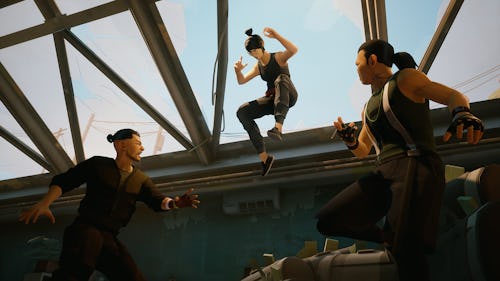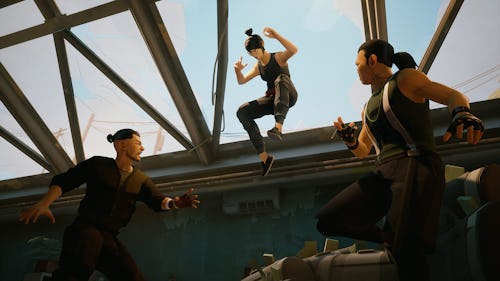
Like Quenten Tarantino’s 2003 movie Kill Bill, Sifu is an unapologetic homage to the classics of martial arts cinema.
Jordan Layani, Sifu’s creative director, describes himself not as an expert on these movies but as a fan. He grew up in France watching Bruce Lee, and then, as a teenager, obsessing over Jackie Chan. Later, he discovered the works of famed director Tsui Hark, pioneer of the “heroic bloodshed” genre. These influences course through the output of the studio he leads, Paris-based Sloclap, which debuted in 2017 with innovative multiplayer martial arts brawler Absolver. In that game, the bruising encounters were set against painterly open-world ruins whose raw, intestinal structure evoked Dark Souls. Sifu is altogether more furious, claustrophobic, and cinematic. You’ll punch, kick, and grapple your way through apartment complexes, drug factories, and nightclubs, each space a carefully crafted ode to a classic film set.
While its story might sound derivative — your character is out to avenge the death of their father who was murdered of by a menacing crew of martial artists — the execution is anything but. The notably deep combat system of Absolver has been distilled to its essence in Sifu, rebuilt around an ultra-fast, no-nonsense strain of kung fu known as pak mei. As your thumbs unleash flurries of volleys and takedowns, you slowly assume a state of trancelike mastery. This mastery also applies to Sloclap, which has seamlessly channeled an entire universe of martial arts movies into Sifu. You’re in the Zone, and so, it seems, are Layani and his colleagues, even if the jury remains out on the extent to which these films are theirs, a team without a single Asian studio lead, to appropriate.
In this interview, Layani, alongside executive producer Pierre Tarno, tells Input several movies that were central in establishing the tone, aesthetic, and story of Sifu, from Gareth Evans’ monumental The Raid to revenge thriller Old Boy, and beyond.
The Raid (2011)
“This is the most important influence in terms of movies for Sifu,” says Layani. “For me, it has a really good balance of choreography, combat, and credibility. We feel the danger of the fight. It shows traditional martial arts as an efficient way to survive a hostile situation.” The action of The Raid, set in the slums of Jakarta, also exists within a structure that mimics a video game — linear, level-based, culminating in a fearsome boss. This is no accident: “I fucking love videogames,” director of The Raid Gareth Evans told IndieWire. It’s tempting to think of video games as only ever being influenced by films, and not vice versa, but titles like The Raid and now Sifu show a much more symbiotic relationship between the two mediums — each one pushing the other to ever-more adrenaline-pumping ends.
The Blade (1995)
Considered a classic of Chinese martial arts cinema, Layani describes this as his “favorite” from the Tsui Hark archives. It’s a nightmarish reimagining of Chang Cheh’s 1967 movie The One-Armed Swordsman that takes a different, notably improvisatory approach to story and action, which is precisely why Layani likes it so much. “It’s how he made the movie — the fact that he wanted to have something like a documentary,” says Layani. “The cameraman didn’t really know what was going to happen in the shot. And it was the same for almost everyone else — the actors didn’t have written dialogue.”
In a way, Sifu is filled with a similar kind of tension: that between choreography and improvisation. The game doesn’t ever know exactly what you’re going to do, and seeing it twist and bend to your input is thrilling in itself.
Old Boy (2003)
“It's a psychological drama but with a revenge story,” says Tarno. Alongside this narrative influence, Sifu references Park-chan Wook’s film directly with a corridor scene that takes place in its very first level. Like Wook’s movie, the action takes place within a 2D framing, and for a few blood-thumping minutes, at least, transforms into an old school side-scrolling beat ‘em up. “There’s a feeling of immersion,” continues Tarno, “of a fight that feels real and hard, and maybe also exhausting.”

Police Story (1985)
In Sifu, just like the Jackie Chan’s Police Story, enemies are just as likely to bonk their head on a table as have a glass bottle smashed in their face. This range of moves, using the “environment as a weapon” was key to the game from its very inception, an opportunity for Layani to turn childhood wonder into digital reality. “When Jackie Chan kicked the chair, it always amazed me as a kid,” he says, “and I really wanted to have this kind of action in the game.” While the action in Chan films such as Police Story, Dragons Forever, and Miracles, can often verge into Buster Keaton or Charlie Chaplin-esque slapstick territory, Sifu presents such moves with a straight face — there’s no nudge or wink when you cave in another enemy’s skull.
The Protector (2003)
“This is another example of a movie inspired by a video game,” says Layani. “In The Protector, there's a scene in the restaurant where the main character goes upstairs and it’s a single shot. Of course, in a video game it’s very easy to make a single shot, but the main thing for us was to have a cinematic approach to the camera.” Layani describes how the game uses two primary cameras — one for when you’re fighting multiple enemies and another that zooms in when you unleash a brutal takedown. “We use a very animated camera to really focus on the impact,” continues Layani. “It’s a real work of direction.”
Blade of the Immortal (2017)
“I was a big fan of the manga first, and the movie surprised me because it managed to fitall 30 volumes into two hours and twenty minutes,” says Layani. There’s two major ways Blade of the Immortal influenced Sifu. The first is the pared back revenge story; the second is the supernatural approach to death. As its title implies, the protagonist of the manga and Takashi Miike’s adaptation is beset by immortality. In Sifu, life and death work a little differently; it’s not game over when you die — you age, and the more you die, the quicker this process becomes. In this way, both Sifu and Blade of the Immortal are simultaneously thrilling and exhausting odes to the act of killing.








